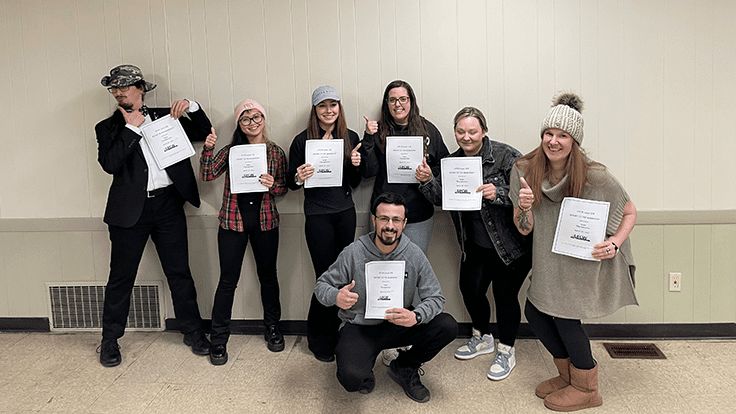Solar Therapeutics Budtenders Ratify First Union Contract
Marijuana Industry News March 22, 2022 MJ Shareholders

Indoor, outdoor, greenhouse or a combination: Greenhouse
Can you share a bit of your background and how you and your company got to the present day?
Sweet Dirt was founded in 2015 by a southern Maine-based husband and wife ([me] and Kristin Pope) medical cannabis caregiver team with years of experience in cannabis and plant medicine. Our years of growing have taught us to respect genetic integrity and the power of living soil, and to embrace the serendipity of cannabis cultivation. Our passion for organically grown cannabis and our real-world experience growing unique, heirloom and premium strains has helped us grow into the company we are today.
At a glance:
- [Roughly] 130 employees (representing over 300% growth in the last year alone)
- 9-acre campus in Eliot, Maine
- 32,800-square-foot adult-use greenhouse (with eight flower and propagation rooms) [with] medical [cannabis] grown in a separate facility
- Completing build out of [roughly] 10,000-square-foot, state-of-the-art manufacturing facility and commercial kitchen
- Medical store in Eliot; adult-use stores in Portland and Waterville, Maine, with two new stores coming in summer 2022
- Maine’s only third-party certified clean adult-use cannabis cultivator
What tool or software in your cultivation space can you not live without?
Two tools quickly come to mind. First up: our irrigation system. We have a Bowsmith non-stop drip emitter and since installing it, we have not experienced a single clog. Not one. Bowsmith has been around since the 70s and, while largely unknown in the cannabis community, Bowsmith is well-known across the world, particularly in large-scale farm settings, for being a game-changing performer. With the Bowsmith system, two silicone bellies expand and contract inside the emitter, which allows particulate to go through the emitter. This allows Sweet Dirt to grow organically and use a precision drip system (instead of hand-watering) and it means we can consistently get water to plants, reducing plant loss and stress.
A second must-have technology for us [is] our 230+ industry-leading Adjust-A-Wing lights. These are staggered throughout the greenhouse flower rooms and designed to mimic the sun’s rays, providing supplemental lighting and giving us the perfect growing environment.
What purchase of $100 or less has most positively impacted your business in the last six months?
A few months ago, we installed wireless sensors from Sensor Push. These sensors, placed above the canopy and at plant level (where there’s more stagnation in the air), monitor temperature and humidity, among other things, 24/7 and send alerts directly to our phones. Each sensor costs roughly $40, but the data and peace of mind is priceless.
What cultivation technique are you most interested in right now, and what are you actively studying (the most)?
The foundation of our cultivation model is our soil. We use only verified organic inputs to create our proprietary “living soil.” The result is soil rich in beneficial bacteria and other constituents [that] allow us to grow the highest quality, organically grown cannabis—with less environmental impact. Studies have shown that conventional fertilizers are detrimental to all life, including the beneficial microorganisms that are a natural part of soil. Furthermore, up to 5% of the total annual yield of natural gas is consumed in the production of such conventional fertilizers. This results in depleted soil, toxic runoff, and reduced viability and yield of conventional cultivation.
Growing in living soil is not easy, but it set us apart and has earned us the “certified clean cannabis” moniker from the Maine Organic Farmers and Gardeners Association. There are a handful of Maine cultivators certified clean in medical cannabis, but we are the only Maine adult-use cultivator to be certified clean.
We are always learning when it comes to cultivation—forever optimizing quality control and plant health to ensure highest quality without compromising what is best for the plant. Of particular interest to us right now is the relationship between the root zone temperature to natural fertilizer input (in the winter, the plants metabolize much slower, so they do not need as much fertilizer, whereas in the summer, when the plants benefit from more natural sunlight and warmth, they require more fertilizer). In other words, less input to get the same output. This is classic winter farming, and for this knowledge, we mostly turn to older greenhouse cultivation texts and books.
How has a failure, or apparent failure, set you up for later success? Do you have a “favorite failure” of yours?
In June 2019, the main operations facility at Sweet Dirt, at our headquarters in Eliot, was destroyed by a fire. The 4,700-square-foot building was the home for the indoor grow, as well as the manufacturing and extraction facility for our then medicinal cannabis program and the impending recreational program.
Upon investigation, the fire was found to be due to a faulty electric box. No one was injured in the fire, fortunately, and we were fully insured. But the loss was difficult, and presented a huge setback, and the team was devastated.
But we quickly came to realize that the decimation and subsequent removal of the burned building allowed for a clean slate of our facilities and opened the door for us to acquire and erect the right facility for our growth—a 32,800-square-foot greenhouse allowing us to capitalize on the state-allowed maximum of 20,000 square feet of flowering canopy for optimal yield. We were also able to work with our landlord to build out a 2,800-square-foot facility which houses our medicinal store and a small post-processing facility. Like the Phoenix, we have risen from the ashes!
What advice would you give to a smart, driven grower about to enter the legal, regulated industry? What advice should they ignore?
First, know all the regulations in the state you are operating in and be prepared to find solutions to work within those regulations while achieving your mission. As you scale up your grow and cultivation team, it is critical to develop standard operating procedures (SOPs) and to continually revisit these and train and retrain cultivation team members accordingly.
There are many that will tell you things can’t be done. We were told we couldn’t grow organically in living soil at the scale we are doing. We were told that we couldn’t grow our organization at the rate we are doing. But it can be done. Do not heed the naysayers. As the old saying goes: Find a way—or make your own.
How do you deal with burnout?
At Sweet Dirt, we focus on cross-training and regularly rotate cultivation employees. Over time, you realize where folks’ passions and strengths and weaknesses are and direct them that way. And, because we have such a hardworking and dedicated team, sometimes we have to force them to take a vacation!
How do you motivate your employees/team?
We have flexible schedules, full-time benefits, holidays, and paid volunteer days. We have luncheons where we come together as a team and strive to make sure everyone’s voice is heard. And our “Good Doobie” program rewards employees who go above and beyond.
What keeps you awake at night?
As much as technology is a necessity in a 32,800-square-foot greenhouse, it is also a challenge. For me, I lie awake at night wondering whether or not the technology will do what it’s supposed to do—will the lights turn on when needed, will we be notified of an electrical issue, etc. One lamp goes out and you increase the chances of that plant or series of plants being overwatered or stressed or overfertilized. A small-scale grower has everything they need because they do it all manually. Technology quickly complicates and compounds probability of failure. We continue to put safeguards in place to ensure technology is doing what it is supposed to do, but it’s a process.
What helps you sleep at night?
Firstly, I still pinch myself over adult-use cannabis finally being legalized in Maine. What a journey that was and continues to be. Also, recognizing that Rome wasn’t built in a day—I have high standards for what I want in terms of flower production and quality, and sometimes I have to look back and realize how far we have come and how much consumers are enjoying the product we are turning out today—and it will only get better.
With regard to cultivation, knowing I have a great team in place and that we are building out and honing our SOPs brings me great peace of mind.
Finally, while I don’t typically smoke to go to sleep, as cannabis usually energize me, my go-to sleep strain would be Lazy Dog (Chem91, East Coast Staple) x (Pacific Northwest Hash Plant by Northern Lights #1), bred by Crickets and Cicadas, and grown here in our Sweet Dirt greenhouse. Lazy Dog relaxes my body and stops my mind from racing over all I want to accomplish when the sun rises the next day.
Editor’s note: This interview has been edited for style, length and clarity.
MJ Shareholders
MJShareholders.com is the largest dedicated financial network and leading corporate communications firm serving the legal cannabis industry. Our network aims to connect public marijuana companies with these focused cannabis audiences across the US and Canada that are critical for growth: Short and long term cannabis investors Active funding sources Mainstream media Business leaders Cannabis consumers










